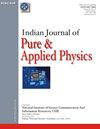拉贾斯坦邦锡卡尔地区铀矿周围地下水中铀的年龄依赖性辐射剂量及毒理学风险评估
IF 1.1
4区 物理与天体物理
Q4 PHYSICS, MULTIDISCIPLINARY
引用次数: 0
摘要
从拉贾斯坦邦西卡尔县皇家村铀矿床附近地区收集的46个地下水样本中的铀浓度使用LED荧光技术进行了测定。计算与年龄有关的年有效剂量、放射和化学毒性风险,以评估与附近地区居民的地下水有关的健康风险。不同样品的铀浓度在4.79-266.28µg/L之间,平均值为74.36µg/L。总体而言,69%和43%的样品的铀浓度分别高于WHO和AERB的推荐限值。过量致癌风险值为1.36 × 10-5-7.54 × 10-4和2.10 × 10-5-1.17 × 10-3,死亡率和发病率平均值分别为2.11 × 10-4和3.26 × 10-4。LADD值范围为0.35µg/kg/day ~ 19.51µg/kg/day,平均值为5.44µg/kg/day。根据AERB和WHO标准,分别有43.4%和84.7%的样品危害商值大于1。利用生物动力学模型估计了铀的滞留量和对人体各器官的有效辐射剂量。还评价了理化参数及其与铀浓度的相关性。TDS与铀浓度呈正相关。本文章由计算机程序翻译,如有差异,请以英文原文为准。
Assessment of Age-Dependent Radiation Dose and Toxicological Risk of Uranium in Ground Water around Uranium Mines in Sikar, Rajasthan
Uranium concentration in forty-six groundwater samples collected from the region near the uranium deposits in the Royal village of Sikar district, Rajasthan, is determined using the LED fluorimetry technique. Age-dependent annual effective dose, radiological, and chemical toxicity risks are calculated to assess health risks associated with the groundwater for the people living in the nearby area. Uranium concentrations of different samples vary from 4.79–266.28 µg/L with an average value of 74.36 µg/L Overall 69% and 43% of samples exhibit uranium concentrations greater than recommended limits of WHO and AERB, respectively. Excess cancer risk values lie in the range from 1.36 × 10-5-7.54 × 10-4and 2.10 × 10-5-1.17 × 10-3 with mean values of 2.11 × 10-4 and 3.26 × 10-4 for mortality and morbidity, respectively. LADD value lies in the range of 0.35 µg/kg/day to 19.51 µg/kg/day with a mean value of 5.44 µg/kg/day. The hazard quotient value for 43.4% and 84.7% of samples is greater than unity according to AERB and WHO standards, respectively. The uranium retention and effective radiological dose to various body organs are estimated using biokinetic modelling. Physico-chemical parameters and their correlation with uranium concentration are also evaluated. A positive correlation is found between TDS and uranium concentration.
求助全文
通过发布文献求助,成功后即可免费获取论文全文。
去求助
来源期刊
CiteScore
1.30
自引率
14.30%
发文量
42
审稿时长
7 months
期刊介绍:
Started in 1963, this journal publishes Original Research Contribution as full papers, notes and reviews on classical and quantum physics, relativity and gravitation; statistical physics and thermodynamics; specific instrumentation and techniques of general use in physics, elementary particles and fields, nuclear physics, atomic and molecular physics, fundamental area of phenomenology, optics, acoustics and fluid dynamics, plasmas and electric discharges, condensed matter-structural, mechanical and thermal properties, electronic, structure, electrical, magnetic and optical properties, cross-disciplinary physics and related areas of science and technology, geophysics, astrophysics and astronomy. It also includes latest findings in the subject under News Scan.

 求助内容:
求助内容: 应助结果提醒方式:
应助结果提醒方式:


